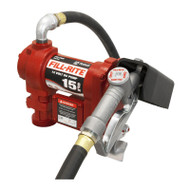Understanding Fuel Transfer Pump Flow Rates
Posted by Steve Fabiszak on Jul 17th 2018
A fuel transfer pump, including models manufactured by Fill-Rite, GPI, and PIUSI, can be a very cost-effective and convenient way to meet fuel dispensing needs in a multitude of applications such as fueling farm equipment, fleet vehicles, construction equipment, recreational vehicles, etc. Each pump model has a flow rate associated with it determined by the manufacturer. Sometimes a user may feel that the specified flow rate on their pump does not match the actual flow rate they are experiencing when fueling their equipment. Fuel transfer pumps with insufficient or low flow rates could be caused by various reasons.
Do I Have A Flow Problem?
To first determine if your pump really does have a flow rate problem, you need to understand how the transfer pump flow rating is calculated. All transfer pumps are rated at the open discharge outlet without a hose, meter, filter or nozzle attached. The rating is typically in Gallons per Minute in the USA (GPM) and Liters per Minute (LPM) in regions where the metric system is primarily used. The addition of the hose and nozzle along with any other accessories such as a fuel filter, meter or automatic nozzle will incrementally reduce the final flow rate dispensing from your nozzle.
Tips to Increase Transfer Pump Flow Rate
While the addition of a filter system will affect the flow rate, the benefit usually outweighs the loss of flow by prolonging the life of the pump. Clogged or older filters are one of the most common causes for low flow rates in fuel transfer pumps. If you have a filter system on the fuel transfer pump it is recommended to change the filter at least once per year. ( see how to select the correct filter here)
The length and inside diameter of the hose will also influence the flow rate of the pump. The smaller the inside diameter (ID) or the longer the length of the hose, the more friction is created resulting in flow rate reduction. It is best to use the shortest length of hose possible for an application. When pumping through a ¾ in. ID hose and a longer length is desired, one way to improve flow loss is to switch to a 1 in. ID hose and nozzle. Increasing the inside diameter of the hose can improve friction loss by up to 40%.
Choosing a Fuel Transfer Pump
When deciding between two pumps with different flow rates that meet the specifications of your application, we recommend buying the pump that will provide the higher flow rate. For pickup truck style transfer tanks that are 100 gallons or less, a 15 GPM pump with ¾ in. ID x 12 ft. long hose is usually adequate. When purchasing a pump for an above-ground fuel storage tank of 500 gallons or more it is recommended to use a 20 to 25 GPM pump with 1 in. hose, especially when using a fuel filter and/or meter.
By understanding how the flow rate of a fuel transfer pump is calculated and how the actual flow rate is affected by your application it can help you make a better decision when selecting a pump. By properly matching your fueling requirements with your budget, you can significantly improve satisfaction with your purchase and meet your fueling needs for years to come.
Click here to find our great selection of
AC Fuel Transfer Pumps or here for DC Fuel Transfer Pumps. We also offer Pump Repair Kits for any maintenance needs.


